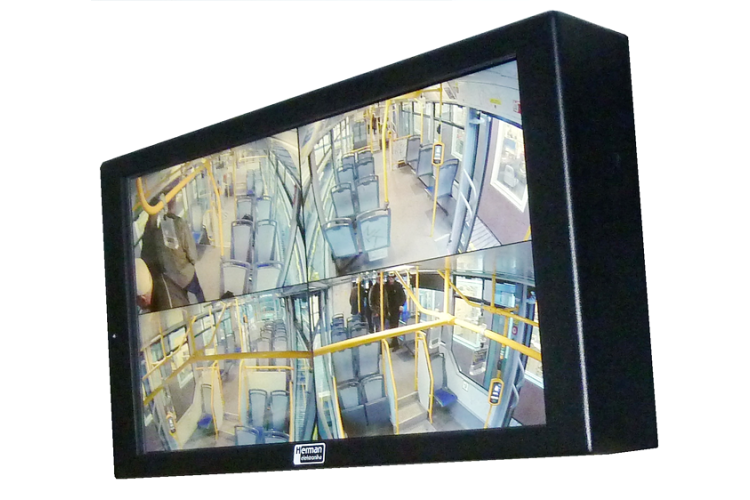Integrated camera system
The system is arranged in such a way that it can form a separate Ethernet network in the vehicle. This configuration is particularly suitable when there are multiple cameras in the vehicle and the data traffic from the cameras does not then burden the bus traffic for the control of the information and check-in system. This advantage is particularly evident when using cameras with real-time data transmission (reversing cameras, taxi cameras, etc.).
Contact us
System description
The description of the camera systems is published in the article Integration of the camera system into vehicle informatics. The principles of the system and the possibility of integrating it into the on-board system are detailed here.
The system is arranged in such a way that it can form a separate Ethernet network in the vehicle. This configuration is particularly suitable when there are multiple cameras in the vehicle and the data traffic from the cameras does not then burden the bus traffic for the control of the infotainment system. This advantage is particularly evident when using cameras with real-time data transmission (reversing cameras, taxi cameras, etc.).
In its current configuration, the system allows:
- monitoring of the vehicle according to set rules,
- monitoring of entry and exit - as they monitor the outside area, they are only switched on when the door is opened,
- monitoring of events behind the vehicle - activated when the vehicle is put into reverse. In this case, the camera operates in real-time mode (image delay is minimized)
- monitoring of events in front of the vehicle
- monitoring the status of the collector on the overhead line - activated automatically when the system is activated on the vehicle.
The system can thus be used as a universal in-vehicle camera system including the recording of the respective cameras at the time of their activation and does not need to be combined with other systems.
Figure 1: Bus arrangement of an integrated CCTV system in public transport vehicles.
The system can work independently or in cooperation with the EPIS 4.0x on-board computer. If it works in cooperation, then it is possible to prepare the data about the cameras in the vehicle in EPCOMP by directly configuring the menu of the on-board computer to call up the displayed cameras on the camera LCD for the driver, including the possibility of configuring other functions.
Composition of the camera system
The supplied camera systems consist of:
- Recording units with a disk (HDD or SSD), which can contain an LCD for displaying, for example, the status of the door area - VCS 156 and VCS 104, units without LCD designed only for recording events in vehicles - type VCS 000, which does not contain an LCD.
- Ethernet bus interconnect switches ECU 08P2, which incorporates PoE with +48V output power to power the cameras directly over the Ethernet bus.
- Vehicle cameras (type is not specified because the type is always selected according to the customer's requirements and, in addition, the production time of the camera type is very limited). The cameras are individually configured according to the requirement for the real delay of the displayed system (e.g. for the reversing camera when the vehicle is reversing, for monitoring of the collector on the overhead contact line, etc.).
- ETH accessories - it is e.g. a power converter for bus cameras according to IEEE 802.3af from type B to type A, suitable for powering cameras monitoring events in front of the vehicle ("crash" cameras).
- Connection to the vehicle - the system allows independent connection to the vehicle using a sufficient number of single-bit inputs and outputs or comfort control via EPIS 4.0x on-board computers. It also has ready inputs, e.g. from the reverse gear, allowing the monitor to be switched to "follow the vehicle" mode.
An example of the simultaneous display of four cameras on a recording LCD - type VCS 156.
Principle of in-vehicle wiring
Principle of in-vehicle camera system wiring:
Principle of on-board camera systems in a public transport vehicle (coupled tram).
Recording management software - video client
The VideoClient software is used to read out encrypted videos from the on-board CCTV system, decrypt them and play back the downloaded footage from the vehicles. Access to the processing is possible only after entering the required password.
- Readout of recordings - after logging into VideoClient, the user selects the IP address of the CCTV system from which he wants to read out videos. After successful connection to the system, the user will be shown basic information about the system status and a list of individual cameras. After selecting a camera, a list of video recordings recorded by the selected camera will be displayed. The list is sorted into days and hours. In the list, the user selects the recordings to download and can then download them to his PC in encrypted form. When downloading, the user can create an incident to which the recordings will be included, or include the recordings in an existing incident. All in-vehicle access to the CCTV system is logged.
Basic application window
- Monitoring downloaded records - when monitoring records, the user selects from the created incidents. After selecting an incident, a list of videos included in the incident is displayed. The videos in the list are sorted by camera, and then by day and time for each camera. The user can watch videos from 4 cameras at once. When viewing footage from multiple cameras, the user can control playback of each video individually or globally for all footage being played. Encrypted videos are decrypted for playback purposes before playback and deleted after playback.
Video playback and preview window.
- Export and delete video recordings - saved video recordings can be exported to MP4 format for further use. Downloaded video recordings can be deleted by ending the incident.https://www.herman.cz/wp-content/uploads/2016/11/vozidlová_síť_KS_161031-600x453.gif





